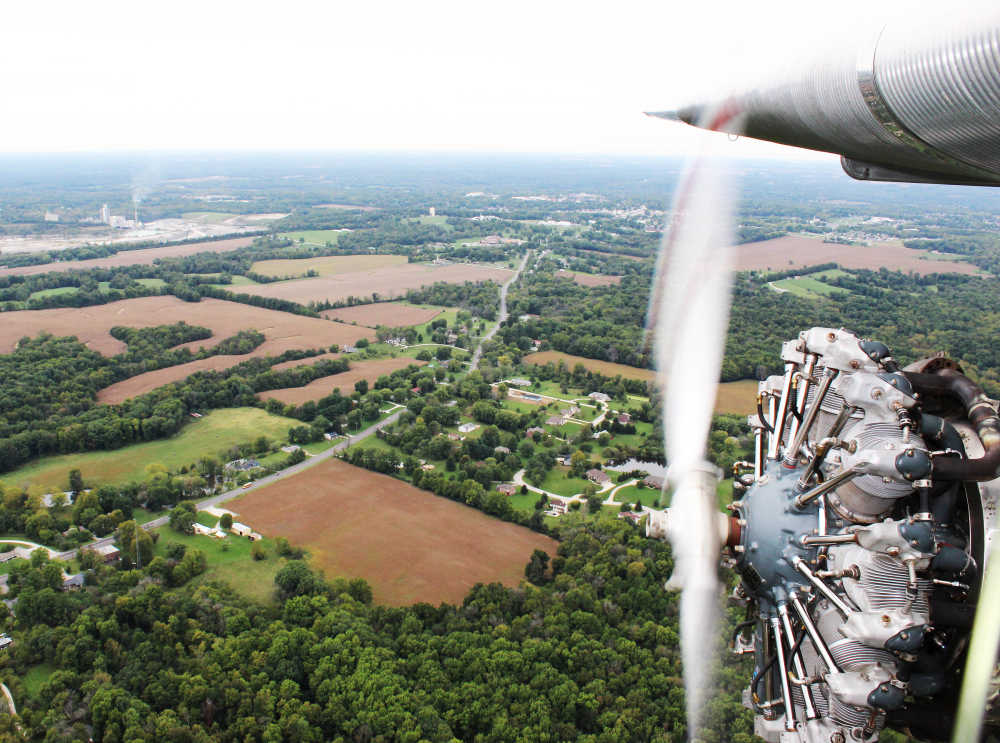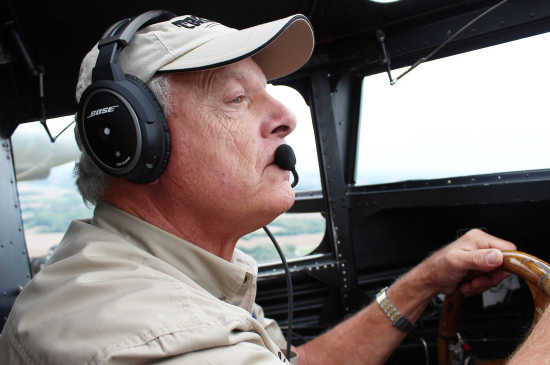Ford Tri-Motor visiting Putnam County Airport

As the skies began to become cloudy and a coolness was in the air Thursday afternoon, this reporter and others were given a little excitement as they flew in an historic airplane that signaled the beginning of commercial flight.
The Liberty 1928 Ford Tri-Motor 5-AT-B aircraft is visiting the Putnam County Regional Airport as part of a tour by the Experimental Aircraft Association (EAA), a non-profit organization dedicated to promoting recreational flight.
The EAA is mainly supported by volunteers who fly and maintain the aircraft that are showcased across the country.
The Ford Tri-Motor, also nicknamed “The Tin Goose,” was an airliner that had an immediate impact when it was first introduced in 1926. The Tri-Motor was the first all-metal, multi-engine commercial airliner to be used for transcontinental flight. After it entered into service as an airliner, it was touted for its dependability and solid construction.
This was owed to its efficient design, as well as its ability to be easily converted from a passenger aircraft to a cargo transport. Indeed, even with the advent of more modern aircraft, the Ford Tri-Motor was still transporting heavy freight into the 1960s to mining operations in the jungles of South America. A Ford advertisement from 1929 proudly declared, “No Ford plane has yet worn out in service.”
Its introduction led the way to other advancements in aviation, including airline terminals and paved runways, as well as mandatory crew training for airline customers.
A total of 199 Tri-Motors were produced between 1926 and 1933, and the aircraft was generally built in the 4-AT and the 5-AT variants (an abbreviation for “air transport” and “Alpha Tango” in the NATO phonetic alphabet). The latter was bigger with a 79-foot wingspan, more than three feet longer than the 4-AT. The 5-ATs also sported more powerful engines. The Liberty Tri-Motor was built with air-cooled Pratt and Whitney Wasp engines that could produce 420 horsepower.
The technical aspects aside, the Liberty Tri-Motor itself has an intriguing history on its own. A month after it completed its first flight in December 1928, it was sold to the Transcontinental Air Transport (TAT) airline and was named City of Wichita. It was so named because it helped establish westbound commercial service from New York to as far away as California. The Liberty Tri-Motor worked in tandem with another Ford Tri-Motor named City of Columbus to complete the journey, which also employed trains on the Pennsylvania Railroad. The service was also the first to provide meals to travelers.

In 1931, the aircraft was sold to Transcontinental and Western Air (TWA), where it helped establish that airline’s routes across the country. From that point, the Liberty Tri-Motor would exchange hands many times and was at one point flown in Honduras and later in Mexico. Its corrugated metal skin was replaced by sheet metal during a restoration in 1951.
After the plane was damaged and put into storage in 1954, it came back to the United States in 1955. It was eventually purchased by William F. Harrah, who founded Harrah’s Hotels and Casinos and which now is a part of Caesar’s Entertainment Corp. Harrah oversaw a seven-year renovation of the aircraft which restored its corrugated metal skin. The Tri-Motor would remain in his private collection until it was auctioned after his death in 1986.
In 1990, it was acquired by the Evergreen Aviation and Space Museum in McMinnville, Ore., where it underwent another restoration in 1996. The Tri-Motor finally landed in its current home in 2014 at the Liberty Aviation Museum in Port Clinton, Ohio, after which it was given its second name City of Port Clinton. Since then, the EAA has leased and maintained the aircraft for display during its Ford Tri-Motor Tour.
The tour makes it a point to highlight the Liberty Tri-Motor’s part in aviation history. But as some of the EAA volunteers will tell you, this is complemented by the sheer sense of exhilaration one gets when flying in it, whether in the cockpit or the fuselage.
This is certainly shared by EAA volunteer pilot Bill Sleeper, who has flown the Tri-Motor for the past three years on the tour.

“It’s just different than modern airliners,” he said as he talked about how it felt to fly the aircraft that once was called the “Queen of the Skies.”
“There’s a different feel to it, and its got its little quirks to it,” he said.
Sleeper has also flown a 4-AT Tri-Motor that the EAA restored in the 1970s and currently maintains. This is the same aircraft that visited the airport in 2012 as part of another tour. As such, Sleeper has about 400 flights' worth of experience in a Tri-Motor cockpit.
But it’s not like he has ever had to worry about a catastrophic event. The Tri-Motor is only a “good weather craft,” meaning that it is not flown in inclement conditions to maximize safety and to preserve it. Sleeper was also matter-of-fact when he pointed out that having three engines provides a failsafe.
“If one goes out, you still have two to get you along,” he said. “Generally, it’s just safer.”
Despite this confidence, the Tri-Motor’s individual quirks can provide an interesting experience for a pilot.
“It’s a little heavy on the controls,” Sleeper said. “It is a little slow to respond, but again, it’s not a modern plane. It’s not immediate and you have to be a little more deliberate.”
However, with the plane capably in his hands, guests experience a thrill that hearkens back to a time when commercial flight was a luxury.
In the end, the Ford Tri-Motor Tour advances the EAA’s mission to encourage participation and interest in aviation and its history. It is this that drives Sleeper’s enthusiasm for volunteering.
“It’s a wonderful experience to be able to do this,” he smiled. “It’s all about the people getting an opportunity to experience a piece of aviation history and get them excited about flying.”
The Liberty Ford Tri-Motor will be offering flights to the public from 9 a.m. until 5 p.m. today at the airport. Cost for a seat is $75 for adults and $50 for children.
Proceeds from the tour will support the EAA and the maintenance of the Liberty Ford Tri-Motor and its other aircraft for future demonstrations.
